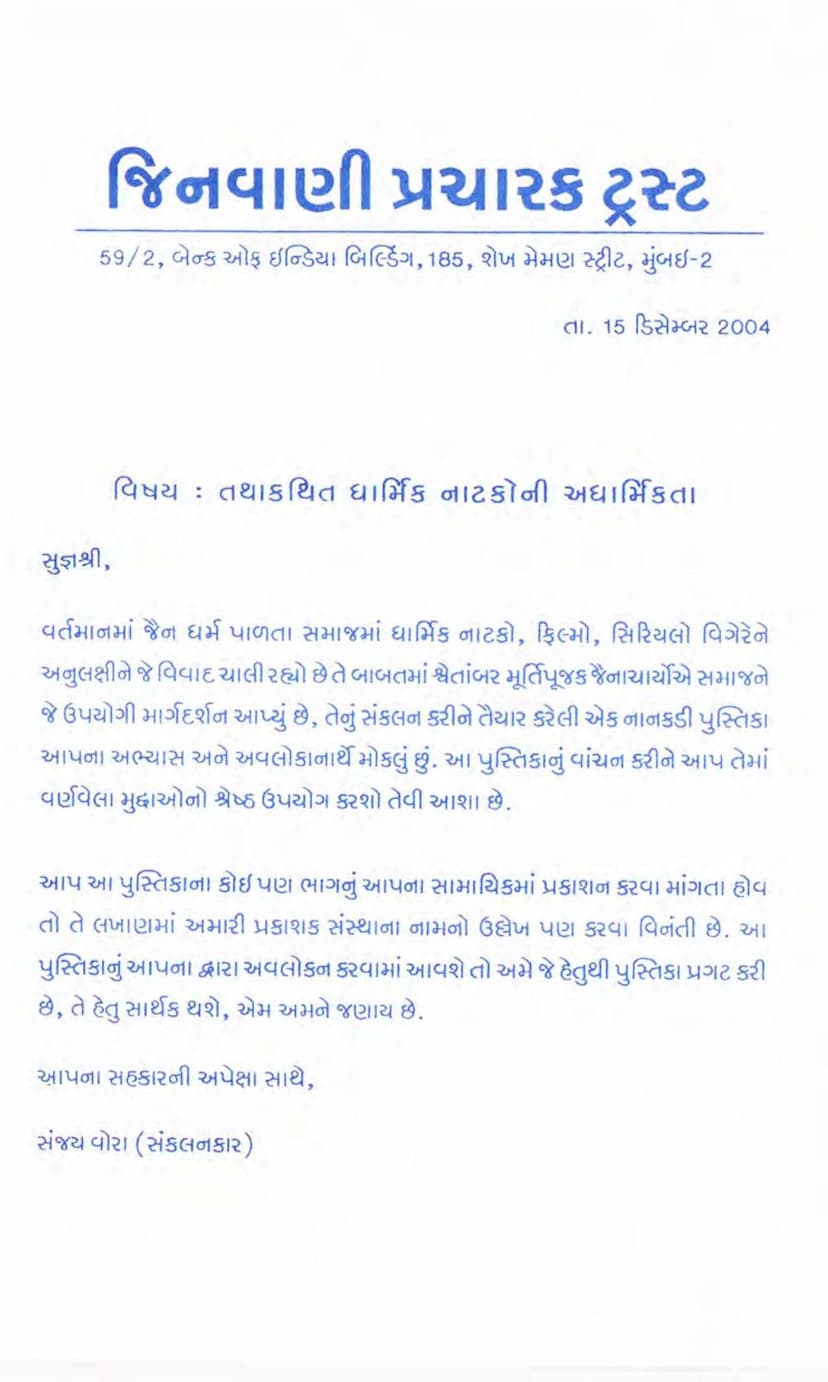Tathakathit Dharmik Natakoni Adharmikta
Added to library: September 2, 2025

Summary
The book "Tathakathit Dharmik Natakoni Adharmikta" (The Immorality of So-Called Religious Dramas), compiled by Sanjay Vora and published by Jinvanipracharak Trust, addresses the controversial use of religious dramas, films, and serials within the Jain community. The publication consolidates the guidance provided by esteemed Śvetāmbara Murtipujaka Jain Acharyas and scholars on this matter.
The central argument of the book is that while presented as religious or reformist, these modern media portrayals often deviate from true Jain principles and can be detrimental to faith and practice. The book highlights several key concerns:
- Misrepresentation and Distortion of Jain Principles: Many dramas and films, influenced by Western ideas or driven by commercial interests, misrepresent Jain teachings, rituals, and the lives of revered figures. This can lead to misconceptions among the general public, particularly younger generations who are easily drawn to entertainment media.
- Desecration of Religious Figures and Practices: The book strongly criticizes the portrayal of Jain monks (Munis and Sadhvis), Tirthankar Lords, and other holy figures on stage or screen. It argues that actors, often lacking the moral uprightness and spiritual understanding required, cannot adequately portray these sacred roles, leading to disrespect and a diminishment of their revered status. The use of costumes, dialogue, and actions that are contrary to Jain monastic discipline is deemed a grave offense.
- Commercialization and Exploitation of Religion: Many so-called religious dramas are produced with the primary motive of profit. The book argues that using religion, its heroes, or its practices for commercial gain is antithetical to Jain principles, which emphasize renunciation and selfless service.
- Impact on Faith and Morality: These portrayals can erode the faith of genuine religious followers, especially those who lack a deep understanding of Jain philosophy. They can also instill negative impressions and superstitions in children, contributing to a decline in moral values.
- Intention Behind the Dramas: The book differentiates between historical narratives that might be inspiring and modern dramas that, under the guise of reform or entertainment, actually mock or undermine Jain traditions like child initiation, the use of temple wealth (devadravya), communal meals (swamivatsalya), and temple construction.
- The Role of Performers and Creators: Professional actors, often leading lives far removed from the spiritual ideals they portray, are deemed unfit to represent Jain holy figures. The book emphasizes that the creators and performers should have a genuine understanding and adherence to Jain Dharma to even consider such endeavors.
- Critique of "Reform" Movements: Those who claim to be reformers but use these media to criticize fundamental Jain practices are seen as misguided and driven by their own corrupted faith. The right to reform, the book asserts, lies solely with learned Jain Acharyas, not with artists or media producers.
- Legal and Ethical Boundaries: The book cites legal precedents where courts have banned films or banned the sale of books that hurt religious sentiments, underscoring that freedom of expression is not absolute when it infringes upon the religious feelings of others.
- Distinction from Traditional Religious Performances: The text clarifies that traditional religious performances during festivals like Anjanshalaka ceremonies, where characters are symbolically invoked and performed by devout individuals in a pure environment, are fundamentally different from commercial dramas. These traditional performances are conducted with utmost reverence and adherence to purity.
- The Unsuitability of the Drama Environment: The atmosphere of a theater or auditorium is often described as conducive to materialism, indulgence, and negative influences, making it an inappropriate venue for religious performances.
- The Role of the Lay Follower (Shravak): The book reminds Jain lay followers of their vows, particularly the vow against unproductive activities (anarthadand), which includes watching such potentially harmful dramas. It highlights that even observing such performances can be considered a transgression.
- The True Purpose of Jain Scriptures: While Jain scriptures mention "dramas" in devotional contexts (like those performed by deities before Tirthankars), these were expressions of pure devotion and not commercial entertainment. Historical Jain dramatic literature was written for literary appreciation and spiritual reflection, not for performance in the modern, commercial sense.
- Conditions for a "True" Religious Drama: The book concludes by outlining strict conditions that must be met if any religious drama is to be considered acceptable. These include having the script reviewed and approved by learned Acharyas, performing it without any commercial motive, using only dedicated volunteers with exemplary character, holding it in sacred spaces, avoiding the portrayal of Tirthankars and monks, ensuring proper segregation of genders, and maintaining strict purity and decorum throughout.
In essence, "Tathakathit Dharmik Natakoni Adharmikta" is a strong condemnation of the commercialization and misrepresentation of Jainism through modern media, urging the Jain community to be vigilant, to oppose such activities, and to uphold the sanctity and integrity of their faith. The compilation includes endorsements and messages from numerous prominent Jain Acharyas, reinforcing the unified stance of the religious leadership against these perceived transgressions.